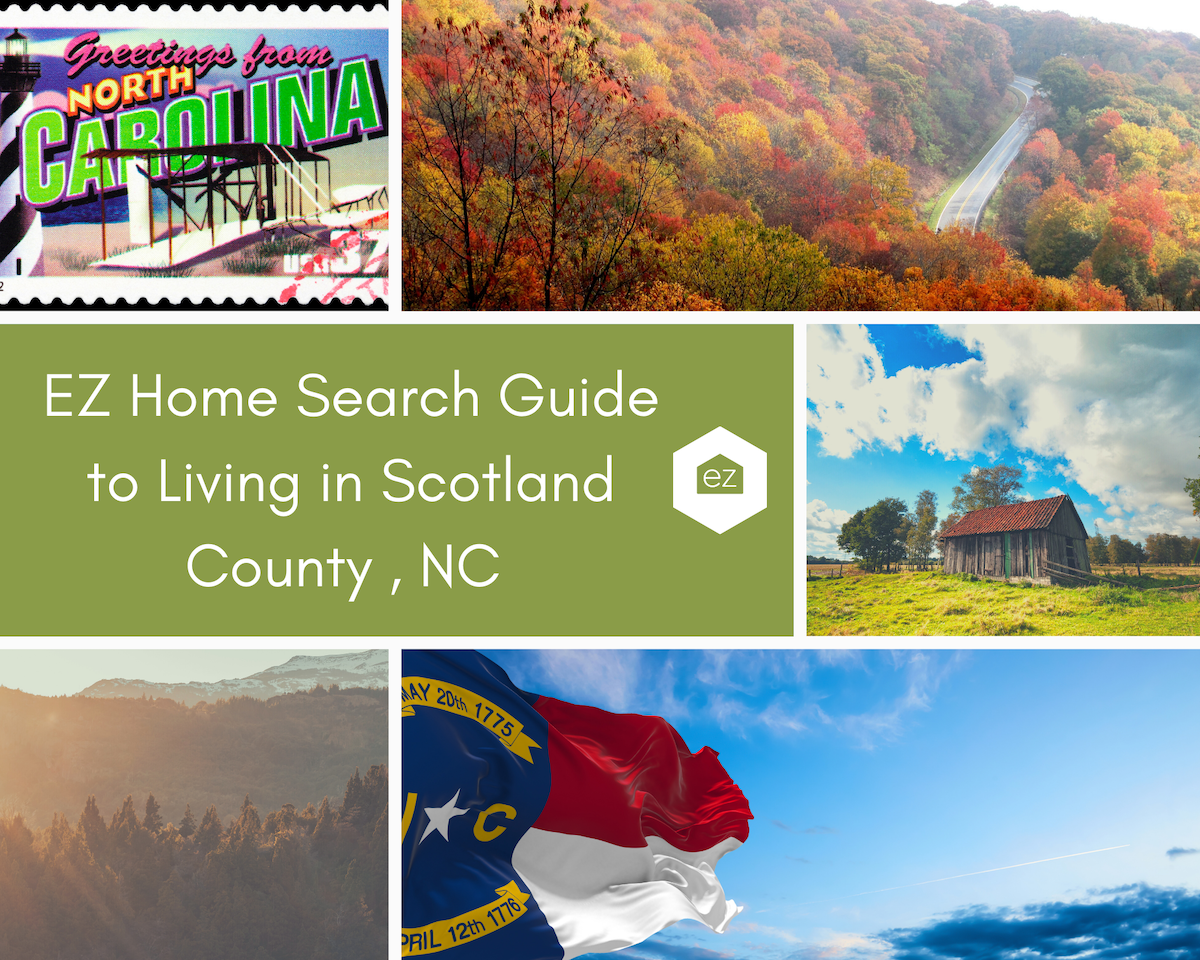EZ Home Search Guide to Living in Scotland County, NC

EZ Home Search Guide to Living in Scotland County, NC
Are you looking for quiet living but with a great location near a developed area? Try Scotland County, NC, on for size. You have a three-time All America City, a rich agricultural heritage, progressive community services, and a laidback lifestyle. When you decide you need a city’s services, Fayetteville is about an hour’s drive.
Learn more about Scotland County, North Carolina. Our guide gives you an overview of living in the heart of the Sandhills region.
About Scotland County
Bordering South Carolina, this southeastern region is known for industry and agriculture. Drowning Creek and the Lumber River, two important geographic features, create the county’s western border.
Scotland County residents live about two hours to the mountains and two hours to the coast by car. Two international airports are within 90 miles. Fayetteville and Fort Bragg are about an hour away. NC Highway 74 turns into Interstate-74 outside Laurinburg, connecting residents to I-95.
Enjoy a mild, four-season climate. The yearly average temperature is 63F. January highs average 54F with a low of 32F. July averages are 92 F and 70F, respectively. The area averages 49 inches of rain a year.
When it comes to the cost of living, Scotland County falls below the US average, which Sperling indexes at 100. Scotland County has an overall 73.2 score, with the most expensive category being health care. The most affordable was housing. Its cost of living is below the North Carolina overall score of 90.3.
Surrounding Scotland County is Hoke, Robeson, Richmond, and Moore counties in North Carolina and Marlboro County in South Carolina.
Scotland County History
Before European settlement, Scotland County was home to various Native American groups. The groups integrated into the settling European Americans, adopting English and other customs. Their assimilation meant they were not subject to removal during the 1830s, but they experienced discrimination and other obstacles, such as denial of the right to vote or bear arms. In the 1950s, the Lumbee Brotherhood was organized to unite the community. The name is derived from the Lumber River. The Lumbee tribe was eventually recognized by North Carolina but is not federally recognized.
Early settlers were mostly Highland Scots, who records show lived in the area as early as 1729. Many more settlers came, including the English, Welsh, and enslaved Africans.
General William T. Sherman’s troops moved through the area during the Civil War. They camped at the Laurel Hill Presbyterian Church and destroyed a gun factory near Richmond Mill dam.
The county was created in 1899 from Richmond County, which was divided to reduce the travel time for residents to the former county seat of Rockingham. The county name documents the early Scottish settlers’ strong historical and cultural influence.
Laurinburg was incorporated in 1877, but its roots date back to 1785 when European settlers first built on a townsite. Development began in the 1850s after a private school was established. There was also a store and blacksmith shop. The town boomed during the 1880s with numerous groceries, general stores, and an Opera House.
The railroad ran through Laurinburg. The companies relocated shops here from Wilmington during the Civil War. The railroad remained important for transporting the region’s agricultural and textile bounty. The town has the nickname “The City of Beautiful Trees.”
The town of Maxton made headlines in 1958 when the Lumbee Nation confronted and overcame the Ku Klux Klan. The tribe challenged the KKK at a public rally due to the group burning crosses on two Lumbee families’ lawns. The event made national headlines.
Scotland County Cities and Areas
As a rural community, much of Scotland County is forested or agricultural. You can experience a tight-knit small-town while living in one of Scotland’s local cities and towns.
Laurinburg is the county seat and a three-time All America City. It is 43 miles from Fayetteville and Fort Bragg. It features historic architecture, and arts scene, and many city services. Around 16,000 people call Laurinburg home.
East Laurinburg developed as a center for textile production. The villages here were built around the textile plants. While close to Laurinburg, it is legally separate from Laurinburg.
Gibson is a small town on the South Carolina border. It has a sparse, suburban feel.
Wagram is a small town between Laurinburg and Raeford. Around 800 people live inside the city limits.
Maxton is partially in Scotland County and Robeson County. It was home to several historically important education centers, like the Flora MacDonald College, which was the first in the state to award degrees to women.
Other towns and areas in Scotland County include Laurel Hill, Old Hundred, and Deercroft.
Scotland County Job Market
The area’s leading employing industries are health care, education, and government. It also has a strong manufacturing and agricultural presence.
Local manufacturers include Cobra, Meritor Heavy Vehicle Systems, Hanesbrands, Service Thread Manufacturing, and Kordsa. Several trade and transportation companies use the county as a center, such as Lowe’s, Maverick Transportation, and Farmers Furniture Company.
Based on the number of employees, the top employers are Scotland Memorial Hospital, Scotland County Schools, the Scotland County Government, Pilkington North America, FCC, Wal-mart, Meritor Heavy Vehicle Systems, Hanesbrands, and St. Andrews University.
As of November 2021, Scotland County did have the highest unemployment rate in the state, coming in at 7.0%. North Carolina’s average rate was 3.4%.
Scotland County Real Estate Market
Scotland County’s real estate market offers diverse options for a small-town, suburban lifestyle or more rural living.
Data from December 2021 showed a drop in new listings over December 2020. The median list price for single-family homes was $200,000, an increase of 29%. The inventory of homes for sale stood at 15, creating a 0.8 months’ supply of inventory. There was one condo/townhome unit on the market for $115,000.
The year-to-date numbers showed a median sales price of $164,450. The median days on the market until the sale was 29. The number of new listings increased in 2021 over 2020, up 13%.
The trend for Scotland County single-family homes generally mimics the regional MLS. The charts show incremental appreciation gains dating back to 2015. A more dramatic increase began in 2020. The median sale prices were generally just above $100,000 from mid-2015 until early 2020. They rose above the $150,000 mark in mid-2021.
Census data from 2015-2019 shows 61% of housing was owner-occupied.
Scotland County Demographics
Based on the 2020 United States Census, 34,174 people lived in Scotland County. The number of residents declined 5.5% from the 2010 Census. The median resident age was 39. Around 25% of residents were 19 years of age or younger.
Demographics show 42% of residents identify as white while 38% identify as black or African American. About 11% identify as Native American.
Around 14% of residents aged 25 and older held a bachelor’s degree or higher. The population was almost 50-50 between urban and rural, with urban living having a slight edge. Around 52% of residents live in a small town or city.
Scotland County Education and Colleges
Scotland County Schools is a rural district serving over 5,500 students with public education. It runs four elementary schools, two middle schools, one high school, and one alternative academy for grades 7-12.
Three private schools are available in Scotland County. The private Laurinburg Institute is the county’s oldest private school. Originally it was the only school in town for African-American students. It now operates a preparatory school.
St. Andrews University is south of Laurinburg and was established in 1961. Around 10,000 students are enrolled at the college. The institution offers undergraduate and graduate programs. Students have 21 majors and 21 minors to choose from. The graduate program provides MBA or M. Ed. The school is known for its unique equine studies program with four related majors and a nationally recognized riding program.
Richmond Community College has a campus in downtown Laurinburg. The two-year school provides associate’s degrees and professional certificates in practical nursing, HVAC technician, and workforce and economic development courses. It also runs the early college program for Scotland County Schools.
Scotland County Health Care
Scotland Health Care is the local community health care provider that runs as a non-for-profit. It includes Scotland Memorial Hospital, the Physicians Network with sixteen medical practices, a family counseling center, and the Memorial Foundation. The Scotland Memorial Hospital has 104 acute care beds.
The Scotland County Public Health Department runs general health clinics with adult and childhood immunizations, maternal health, family, and child health programs.
Scotland County Things to Do
See the “Soul of the Carolinas” in Scotland County’s outdoors. Appreciate the rolling sandhills at one of the local parks or game lands.
Lumber River Chalk Banks State Park on the wild and scenic Lumber River. Riverbank and pier fishing is ideal for catching catfish, largemouth bass, and black crappie. The facilities include boat ramps, picnic sites, hiking trails, and camping.
The Sandhills Game Land is an expansive nature reserve home to numerous wildlife species. The lands are available for hunting, hiking, and birding. The lands sprawl across three counties and have a total of 58,000 acres. Most of the game lands are in Scotland County’s northern area.
Lumber River is a blackwater river with 81 miles designated as a national wild and scenic river. It presents canoeing challenges from mild to moderate, with hour-long to overnight trips possible along its river sections. There are 24 canoe access points, with several in Scotland County.
The Scotland County bicycle route system runs for 147 miles. This trail uses lightly traveled, paved roads favored by local bicyclists to link towns for peaceful rides through the countryside. It consists of three numbered, signed routes and several unsigned connectors.
St. Andrews Equestrian Center is a 300-acre facility with four barns, three arenas, an outdoor show and teaching area, permanent jumps, and hunter trial courses. Tours and training sessions are open to spectators but call ahead. Events and competitions are held throughout the year.
Kuumba Festival highlights Scotland County’s African American cultural heritage. It features dancing, drumming, storytelling, and delicious cuisine. It is typically held on the last weekend of September in downtown Laurinburg.
Scotland Highland Games is the first Saturday in October and is a major tourism draw. Expect all the hallmarks of the Scotland Games, with bagpipe performances, sheepdog showings, food trucks, stone throws, hammer throws, and more.
Storytelling Festival of Carolinas takes place at the Storytelling and Arts Center of the Southeast in Laurinburg. The event draws performers and spectators from all over the globe.
Christmas on Main is hosted on the Sunday before Thanksgiving. Laurinburg has a Christmas parade and other holiday-themed events throughout December.
Scotland County Local Attractions
The North Carolina Rural Heritage Center is headquartered at the John Blue House. It presents the cultures and heritages that have shaped Scotland County and the Piedmont of North Carolina. The Center includes a Heritage Village with example homesteads and businesses from the 1800s, the Museum of Agriculture and History, and the Indian Museum of the Carolinas, which offers exhibits on the life and homes of Native Americans through the centuries.
Old Laurel Church dates back to 1797. It was one of the few churches to invite African-African enslaved people to worship, and it welcomed formerly enslaved people. Visitors can see signatures from Union soldiers in the church tower.
The Outback Motorsports Complex is where ATV and off-road enthusiasts enjoy natural terrain obstacles and racing events.
Scotland County Dining
Your most diverse options will be centered around Laurinburg. Like many small-town communities, you have fast food options like McDonald’s, Bojangles, and Hardee’s. The local venues include popular Americana cuisines like Mexican, pizza, and Italian.
Try some local Carolina BBQ with influences from both sides of the border. Being this close to the ocean, you also have classic fish camps.
Cypress Bend Vineyards and Winery began in 2005 cultivating varieties of muscadine grape. The vineyard along the Lumber River hosts events throughout the year.
Scotland County Shopping
Scotland County residents have a selection of general retailers and small-town shopping. Most locally owned businesses and boutiques are concentrated around Laurinburg. General goods are available at Wal-Mart.
Living in Scotland County. NC
Scotland County, NC, has a rich heritage that dates back before European settlement. The diverse people add to the arts and culture scene. The St. Andrews University Equestrian Center and the NC Rural Heritage Center are unique attractions.
As for the lifestyle, you have thriving small towns and wide-open spaces. The pace is certainly laidback, and the people are friendly. Let life be yours in Scotland County, NC.
Start Your Home Search
Preston Guyton
Share this Post
Related Articles
Living In
Your EZ Guide to Living In Salisbury, MD
Living In





